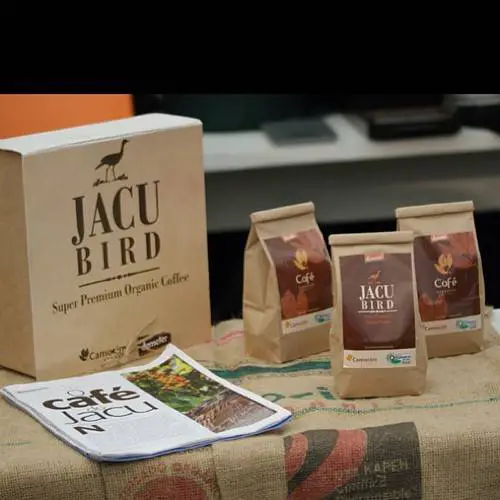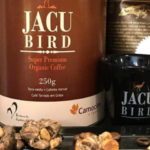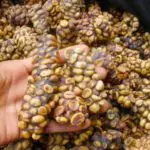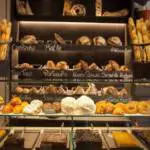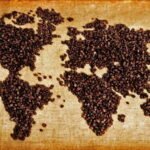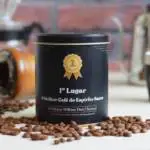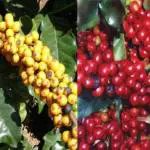If you know a little about coffee, you’ve probably heard that Brazil is the top producer of the crop and, surprisingly to some, the number one coffee consumer too. (not per capita, that title belongs to Finland).
Although coffee beans where first found in Ethiopia, some species were exclusively bred in Brazil and are exported to some other top coffee producing nations.
Most folks usually just hear about Arabica coffee beans, but have you ever wonder what species are those beans from?
Exclusive Brazilian Coffee Species
Conteúdo / Atalhos:
Today we’re going to shed some light into some of those probably never heard of coffee species, and some brands that are getting a lot of attention in Brazil lately.
And no, those aren’t the typical brands mentioned on most blogs in English.
So, what are some of these exotic and unique coffee species that come from Brazil?
Here’s the top 3 coffee species native to Brazil or engineered in the country:
- Red and Yellow Catuaí Coffee;
- Arara Coffee and;
- New World Coffee.
Red and Yellow Catuaí Coffee
These species are not found in nature, they were created in the laboratories of the Instituto Agronômico de Campinas (IAC), in São Paulo State.
It was the first man-made Arabica coffee created, in 1972. A product of the hands of Doctor Alcides Carvalho a researcher emeritus at the IAC.
This a 100% Brazilian Native species, although it’s been widely spread to most of the other top coffee producers in the world. These two species have lately become the darlings of the best coffee producing farms in the country and some of the best local brands also use them these days.
Catuaí coffee is the result of a cross bred between Caturra e Mundo Novo Coffee, where 75% of it is bourbon and 25% if of Típica coffee.
One of the main characteristics of this cross bred coffee is its low height, which does not exceed two meters. This was intentionally engineered by scientists to make the harvesting process easier and more efficient.
Catuaí coffee has a full bodied flavor and high productivity, characteristics inherited from the Mundo Novo species.
It is possible to find Catuaí in two colors: yellow and red. Both adapt very well to hot regions and low fertility soils. It is for all these reasons that the variety is present in most plantations in Brazil.
These coffee plants also has a quick harvesting time, bearing fruit just after two years of planting – the vast majority of other species takes up to 5 year for this to happen.
In the cup, Catuaí Coffee, both yellow and red, are light and smooth, with a medium acidity. It has a very sweet and light flavor.
The yellow variety is slightly less full-bodied than the red Catuaí.
Arara Coffee (Macaw Coffee)
Arara coffee is another variety of beans that is natural from Brazil. But unlike Catuaí, its birth happened through a natural crossing between Obatã Coffee and Yellow Catuaí.
The history of this variety begins in 1988, when IAC researchers discovered it in Brazil.
The researchers noticed yellow-toned beans on some coffee plants they were analyzing. What they found out on those beans is a variety with high production, resistant to pests and diseases and very easy to grow. Those yellow-toned beans are what we call now Café Arara.
There is no concrete evidence about the exact birth of the Arara Coffee, but there are records that show how the species emerged.
The first yellow Arara coffee seeds were planted in the early 2000s, in Ibaiti, Paraná State.
Then those seeds were sent to the Experimental Farm in Varginha Minas Gerais State and to the Coffee Research Center. At the Coffee Research Center, studies were conducted on the Yellow Arara Coffee to better understand its cultivation and productivity.
Over the years, this species has spread among many Brazilian coffee growers.
The variety creates a sweet, light and very balanced coffee.
New World Coffee
New World (Mundo Novo) is also a Brazilian variety. It was discovered in 1952, in the city of Mineiros do Tietê, São Paulo State.
Researchers planted seeds in Mundo Novo, a city in São Paulo State that is now called Urupês.
Embrapa (Brazilian Agricultural Research Corporation) scientists selected mother plants that would give rise to the New World. Shortly thereafter, they proved to be super productive and resistant in the field.
Due to these results, the institution decided to bet on the new variety and began to distribute the new discovery throughout the Brazilian coffee market.
Since then, Mundo Novo is the most cultivated Arabica varietal in the country, alongside Catuaí.
It is a plant that adapts well to any climate and altitude, although grains grown at 800 meters in height show better quality.
The only downside is that this variety is very prone to rust, something the grower has to keep an eye on.
In the cup, the coffee from these beans has a strong and sweet flavor, with a medium body, medium acidity and intense roasting perfume.
It has aromas of milk chocolate and caramel.
Now, let’s talk about some excellent Brazilian coffee brands that are getting a lot of attention lately in the country…
Top 11 Brazilian Coffee Brands You might’ve Never Heard of:
- Café Geisha Café Dutra
- Café Grão Baggio
- Café Intenso Orfeu
- Café Microlote Octavio Grãos
- Café Santa Monica
- Café Latitude 13
- Café Fazenda Pessegueiro
- Café Dutra Especial
- Café Cia Orgânica Daily
- Café Baggio Aromas
- Café Bravo Contralto
Most of these coffees are available on the Brazilian Amazon and can be sent overseas.
To find out more about these Brazilian Coffee brands, click here…
If you’re looking for the rarest coffee beans in Brazil, check out the Jacu Bird Coffee (Café Jacu).
What is Jacu Bird Coffee?
Jacu Bird Coffee is the rarest and most expensive coffee from Brazil.
If you’ve never heard of it, Jacu Bird Coffee is the Brazilian “Kopi Luwak”.
The owner of Fazenda Camocim, which is located in Espírito Santo State, one day realized that the coffee beans from his plantation were being eaten by the Jacu, a bird from the Atlantic forest.
The farmer contacted the local environmental agency asking to carry out a population control of the bird. But you know governmental agencies, they usually take their time to sort things out. So in the meantime, the farmer heard about the Kopi Luwak Coffee. That coffee made from civet’s feces in Indonesia.
Soon, what was a problem became a solution.
The coffee beans eaten by the Jacu bird became Jacu Bird Coffee, a sweet bean, of high quality and more acidic than the fruits grown in a traditional way.
In addition to its different cultivation, Jacu is a super rare coffee, since its production depends on the bird, which consumes the beans naturally. This makes productivity lower, which is why its price is so high.
Also, if compared to other coffees “made” from animal poop, the Jacu Bird Coffee does not use caged birds to get the beans, as the birds are native from the region and freely live in the forest around the farm. This contrasts with to some claims made against some producers of the Kopi Luwak, the Monkey Coffee and the Elephant Coffee, which supposedly keep feeding the animals coffee beans non-stop in order to scale production.
Wrapping it up
With all these coffee varieties, flavors and great brands, make sure Brazilian Coffee is in your list, next time you’re filling up your pantry! You might be surprised at how great some of these coffees are and also how affordable they are too!
